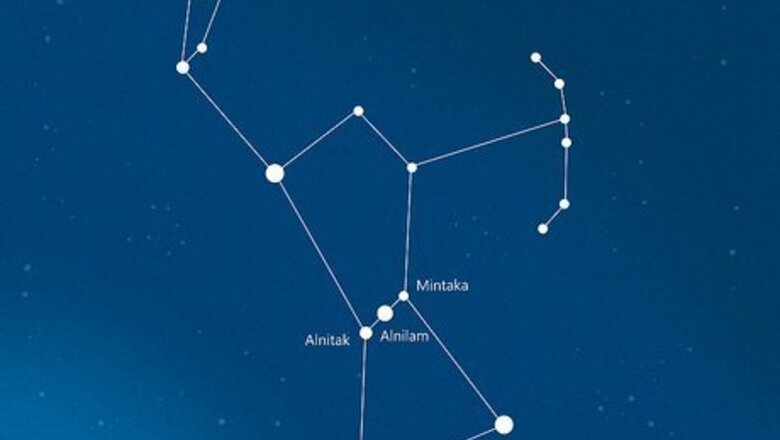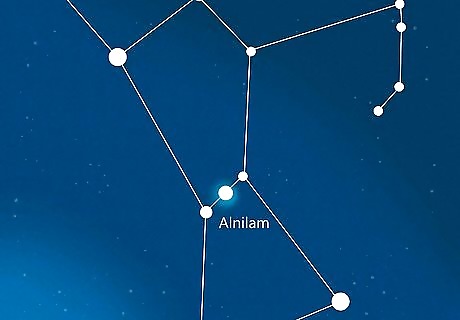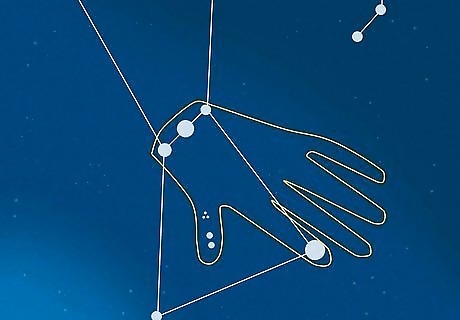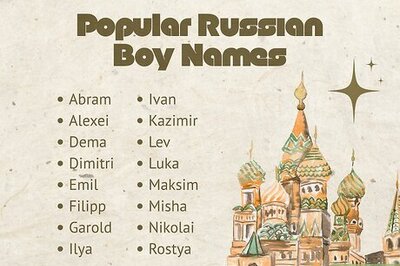
views
X
Trustworthy Source
NASA
Independent agency of the U.S. government in charge of the aerospace research and the space program
Go to source
Orion and his belt are one of the most renowned and recognizable constellations, with a long history across many different myths. We’ll tell you everything you want to know about these special stars, as well as their spiritual significance and their presence across cultures.
- Three bright stars in a line make up Orion’s Belt, part of the Orion constellation. The Belt consists of the stars Alnitak, Alnilam, and Mintaka.
- In Greek mythology, Orion was a great hunter who wielded a club or a sword. In the sky, he pursues the Pleiades and runs from Scorpius the scorpion.
- Spiritually, spotting Orion or his belt may indicate strength, spiritual intuition, attention to detail, and good luck.
Which constellation has 3 stars in a row?

The constellation that has 3 stars in a row is Orion’s Belt. When you use a telescope or look up at the night sky and spy 3 bright stars in a line, that’s most likely the iconic Orion’s Belt, which itself is part of the Orion constellation. His belt consists of the stars (from east to west) Alnitak, Alnilam, and Mintaka. Orion’s Belt is actually an “asterism,” not a constellation. An asterism is a small pattern within a larger constellation, in this case Orion.

The Summer Triangle and the Teapot also feature 3 bright stars. The Summer Triangle constellation consists of Vega, Denab, and Altair, which form a large, bright triangle best seen in the summer months in the Northern Hemisphere. The Teapot lies in the summer skies of the Northern Hemisphere, and consists of 8 stars, 3 of which form a curved line that make the “spout” of the teapot—Kaus Borealis, Kaus Meridianalis, and Alnasl. Like Orion’s Belt, the Teapot is an asterism, not a constellation. The Teapot sits within the constellation Sagittarius.
How do you find Orion’s Belt?

Find Orion’s Belt above the southern horizon in northern latitudes. In the northern hemisphere, Orion appears through autumn, winter and spring. Around July, it rests just above the southern horizon, and moves southwest as time passes. In May, it’s visible on the western horizon, but sets shortly after sunset. Use a night-sky guide like In The Sky to more precisely locate stars in your location at any time of year, or apps like Star Walk to help you stargaze. Also find Orion’s Belt by looking for the 2 brightest stars in the sky, Rigel and Betelgeuse. Betelgeuse is Orion’s “armpit,” and Rigel is his “knee,” and the Belt rests between them. For easiest viewing, let your eyes adjust to the dark for 15 minutes, and move to a dark location with little light pollution.

See Orion’s Belt in the northern sky in southern latitudes. In the southern hemisphere, Orion’s position is somewhat inverted. He appears high in the northeastern sky in January, with his belt parallel to the horizon. He disappears during early winter, but reappears in August, sitting just above the eastern horizon in October. It’s easiest to see Orion’s Belt between the latitudes 85 and minus 75 degrees. Just below Orion’s sword you can find the Orion Nebula, which is 1,300 light years away and visible from Earth.
Stars of Orion’s Belt

Mintaka Mintaka (Delta Orionis) is the westernmost star of the Belt, and is about 900 light years away from Earth. It’s not actually a single star, but a complex system of 5 stars that are very close together, so close that to us they look like a single star. “Mintaka” comes from the Arabic word for “belt.”

Alnilam Alnilam (Epsilon Orionis) is the center star of Orion’s Belt, and is more than 1,900 light years away from Earth. It shines with the combined strength of over 800,000 of our own Suns, but appears about as bright as any other star in Orion’s Belt due to its distance. It’s also a blue supergiant nearing the end of its life, meaning that as it burns, it’ll change from blue to red and get even larger before becoming a supernova. Alnilam means “belt of pearls” in Arabic.

Alnitak Alnitak (Zeta Orionis) is the easternmost star of the belt, and is about 800 light years from Earth. It’s 10,000 times brighter than the sun, with 20 times its mass, and burns at a bright blue color. Alnitak is Arabic for “girdle.” Like its companion Alnilam, it’s nearing the end of its life as a star, and will become a supergiant in a few million years, then go supernova after that.
Spiritual Meanings of Orion’s Belt

Orion’s Belt symbolizes serendipity and good luck. The 3 stars of Orion’s Belt aren’t quite in a straight line, but very nearly line up. This represents things aligning for yourself in your own life. You may be feeling a bit off-kilter or like things aren’t going your way, but looking up at the night sky and seeing Orion’s Belt may be a sign that good luck is coming, you just need to stay positive and optimistic. Calm yourself down by taking several deep breaths—5 seconds in, 5 seconds out. You might find that things are a bit more manageable with a level head.

Orion’s Belt represents strength and fortitude. Across many myths, Orion is said to be a great and powerful hunter. His appearance calls to mind strength, perseverance, and the ability to get things done. Seeing him in the sky encourages you to stay motivated to achieve your goals. Like a hunter stalking his prey, you will soon be rewarded for your efforts. Stay focused on your goals by breaking them down into smaller, more achievable chunks. Before you run a marathon, learn to run a mile.

Orion symbolizes strong spiritual connections and purity. According to Greek myths, Orion earned his place in the heavens after dying in battle. The good news is you don’t have to die in battle to achieve your spiritual elevation. Being drawn to the Orion constellation may indicate that you have naturally attuned spiritual senses, or that you’re sure of your own spiritual path. Trust your intuition and let it guide you to where you ought to be. Orion is also sometimes a symbol of spiritual rebirth, having been “rebirthed” into the heavens. He may come as a sign that you, too, will have a spiritual rebirth sometime soon.

Orion symbolizes close attention to detail. Orion is most easy to see in late July and August, and again in the winter months. If you spot him outside of that time frame, it may be a sign that you possess a keen attention to detail. Nothing slips by you, and you’re able to spot even the faintest traces of light. That sharp eye serves you well and helps you analyze your relationships and life path, and find a way forward through hard times. This may also be a sign that, as you are able to spot Orion, a higher power also sees and watches over you.
Orion’s Belt in Different Cultures

Greek In Greek mythology, Orion was a hunter and the son of Poseidon, who’s often described as tall, handsome, and wielding an unbreakable bronze club. One myth sees him fall in love with and pursue the seven sisters (the Pleiades constellation), but not before Zeus sweeps them into the sky, where Orion chases them at night. In another myth, he drunkenly pursues the daughter of a king, who blinds Orion as punishment. Orion meets an Oracle who tells him to walk toward the sunrise to be healed, which is why Orion faces East in the night sky. Other myths have Orion fight a giant scorpion (Scorpius) after his mother boasts that Orion can defeat any beast on earth. Tellings of the myth vary, but all of them see Orion and Scorpius separated on opposite ends of the sky after Orion’s death, with Orion fleeing Scorpius as it rises.

Sumerian The constellation itself originates from Sumerian mythology and the myth of Gilgamesh. In it, the constellation is a hero named Orion URU AN-NA, which means “the light of heaven,” who fights the bull of heaven, or Taurus, which was called GUD AN-NA.

Egyptian Ancient Egyptians believed the stars of Orion’s Belt were where the soul of the god Osiris rested. Osiris was the god of the dead who was born to an earth deity and a sky goddess, and who went on to rule Egypt. Osiris was said to have been killed and the parts of his body separated by his envious brother, but his wife, Isis, reunited his body and resurrected him.

Hindu In hindu mythology, Orion is connected to Prajapati, a creator god whose daughter changed forms to escape her father’s inappropriate desires. One of her forms is present in the Taurus-Orion constellation. Orion also contains the form of Rudra or Shiva trying to separate the father and daughter. Other forms of the myth say that Orion’s belt is an arrow that pierced Prajapati.

South African South African cultures have many myths about the Orion constellation. The Namaquas believe that the Pleiades are the daughters of a sky god, and that their husband shot an arrow (Orion’s sword) at a group of zebras, represented by Orion’s Belt, but missed. The husband claimed he missed because a mighty lion, Betlegeuse, guarded the zebras, and he was afraid to retrieve his arrow. The Tswana people believe the stars in Orion’s sword are 3 dogs chasing 3 pigs, which make up Orion’s Belt, possibly because hogs often have litters while Orion is visible in the sky, and often have litters of 3.

Native American The Crow, Hidatsa, and Lakota peoples of the Great Plains see Orion’s Belt as the wrist of a great hand with its fingers stretched to the south, and the club or sword as a thumb. This originated from a legend in which orphaned hunter twins search for the trickster named Red Woman who killed their mother. Red Woman tried to escape by reaching into the sky, only for the twins to sever her hand. In Cree mythology, the 3 stars of Orion’s Belt are known as “The Three Chiefs.” In Inuit mythology, they’re skilled hunters known as “Ullaktut.” Many nations in California saw the Orion constellation as a hunter with a bow facing down his prey, often a mountain goat or sheep. The Kwakiutl peoples on the Pacific coast see the Orion constellation as a hunter known as “Harpooner of Heaven,” who rides in a canoe and releases fog from a box where he stores it.




















Comments
0 comment